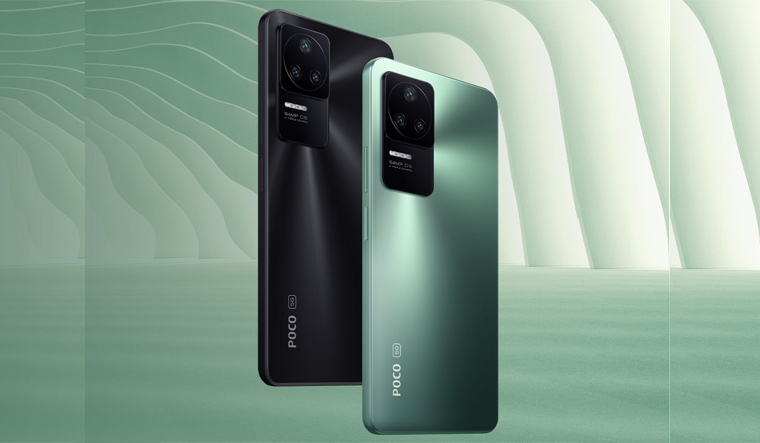Poco has been steadily making strides in the budget segment of smartphones. While it wouldn’t be correct to say they are separate from their parent Xiaomi, they have kind of made their own brand in the Indian market. The Poco F4, at a base price of Rs, 27,999 and going up to Rs. 29,999, is one of its costliest devices so far. Let’s try and see if it’s worth its price tag.
Poco’s F4 comes in night black black and nebula green colour options, and latter is the one I tried. The device has a 6.67-inch Super AMOLED display with thin bezels and Gorilla Glass 5 on top. The back hosts a triple camera setup with some camera description embed on it (would have preferred less of that), Poco branding towards the bottom and a somewhat matte finish that goes well with the sober colour, a little different from the bright and colours we have seen from Android smartphones in the past 18 months or so. The phone weighs under 200 grams and is quite but not hugely broad and still quite comfortable to carry around. The right side houses the volume buttons, Power/lock key and that’s where the fingerprint scanner is also located. The stereo speakers are at the top and bottom, while the top also has infrared port as well as the secondary mic, and the bottom has the USB type C port, primary mic alongside the SIM card slot.
The display on the device is a Super AMOLED (2400x1800) full HD+ with a 120Hz refresh rate. It supports HDR10+ as well as Dolby Vision for playback. The punchole camera on the front seems to take quite a smaller area as compared to most other phones, so credit to Poco for that. The display is sharp, punchy and bright to be used under direct sunlight. It’s more than good enough for playing your high-resolution videos or viewing images. HDR playback is also decent and Dolby Vision output is also not bad either, some nice additions to have, but I wouldn’t say the output really make a huge difference on this display compared to a higher-end device. The front-facing 20MP (f/2.45) camera takes nice detailed shots though its low-light shots could do with some tweaking; otherwise, would suggest you take shots without AI and HDR enabled since Poco tends to “beautify” your photos (which we have seen a lot of times before).
On the back, the device sports a triple camera system – 64MP (f/1.79) with OIS, 8MP (f/2.2) ultrawide camera and a 2MP (f/2.45) macro camera. The device can take quite sharp and well lit photos. In broad daylight, the phone handles contrast and colours well and can capture moving subjects somewhat okay. In low light, with the Night option selected, the photos came out quite okay, not too artificially bright, but then a little out of details at times. The camera app is smooth and responsive to use. The phone can take 4K 120FPSbut 4K 60FPS and 1080p 60FPS videos are more usable for sure, especially the full HD video outcome wasn’t bad and the video had a decent dynamic range provided the phone is kept still when recording.
The phone is powered by Qualcomm’s Snapdragon 870 chipset along with a 12 GB LPDDR5 RAM and a 256GB UFS3.1 storage. The phone runs on Android 12-based MIUI 13.0.3 with the June security patch. The phone performed really well in day-to-day tasks and didn’t show any hiccups when opening or closing apps, switching between apps, using two apps at once or while scrolling inside an app with another app streaming music in the background. MIUI13 looks a lot similar to its previous iterations, though somewhat cleaner, but not a whole lot. It seems a little better optimised in terms of handling animation and apps running in the background. One thing I noticed is that, with Home screen layout locked, one can’t app icon shortcuts. Another thing missing, still, is no copy-paste option the share menu, so you have to install an app, though Android 12 (like previous versions) has its own clipboard, but that seems to be missing again. There’s a new font and it seems to gel in well with the overall OS look and feel. A few new widgets have also been added. Notifications can be viewed from a single swipe down from top left, and from the top right you get the connectivity shortcuts, by default.
The phone carries a 4,500 mAh battery unit and comes with a 67watt Sonic charger in the box. It charges from 1% to full in about 60-70 minutes, and lasted a little under a day most of the time. More often than not, with heavy usage, the phone requited to be charged again the same day, and even with moderate usage, it didn’t have much left in the tank. Battery backup isn’t too bad but it isn’t too great either, let’s just say.
The connectivity options on the phone – WiFi 4G/LTE (has 5G too, but sill untestable), NFC and Bluetooth 5.2 all work without any glitches. Call audio and mic quality are top notch and GPS performance isn’t something to worry about either. Stereo speakers on the top and bottom are quite punchy and loud enough for video playback and calls. The fingerpring scanner mounted on the side is accurate and responsive, for as long as used, it rarely ever failed to unlock the device with the correct finger/thumb in one go. You can choose whether you want the phone to be unlocked with a full press or a touch on the fingerprint scanner.
In conclusion, the F4 is another value for money offering from Poco that gives a lot of juice for its price. It has a sharp and bright display, a capable set of cameras, okay-ish battery life, a really nice and sober design – making itself worthy of your consideration list for if you have a budget of around Rs. 30,000.



